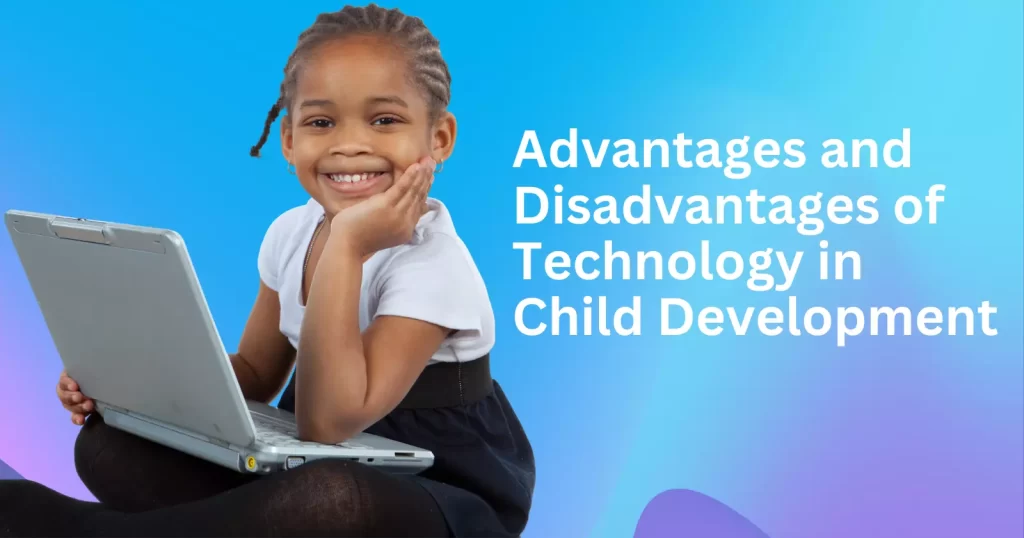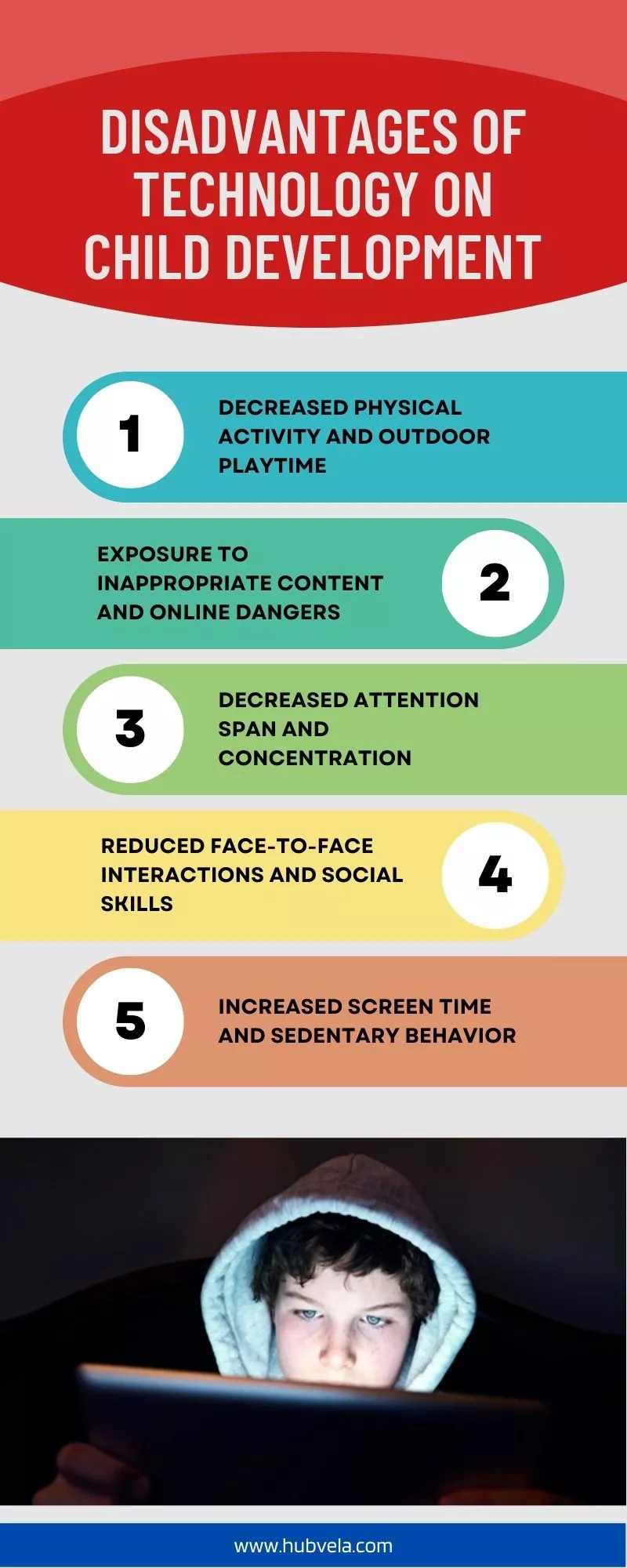Technology has become an integral part of our lives, and its impact on child development is a topic of much debate.
While some argue that technology can enhance cognitive development and provide new learning opportunities, others express concern about its potential negative effects on social skills and physical health.
In this article, we will explore the advantages and disadvantages of technology in child development.

--Advertisement--
Advantages of Technology in Child Development
In today’s world, technology has become an integral part of our lives, and it’s no different for children.
While some may argue that technology has a negative impact on child development, others believe that it can have numerous benefits.
We will explore the advantages of technology in child development and how it can help children learn and grow.
From supporting STEM learning to providing new opportunities for children with physical or developmental challenges, technology can be a valuable tool in a child’s early development.

1. Improving Cognitive and Intellectual Development
Technology can have a positive impact on a child’s cognitive and intellectual development. Digital tools can help children develop cognitive flexibility, problem-solving skills, and creativity.
Additionally, technology can provide access to a wealth of information and resources that can enhance a child’s learning experience.
However, it is important to note that technology should not be relied on as the sole means of learning.
Children still need hands-on experiences and interactions with caregivers to develop the right skills to become independent and lead healthy and successful lives.
Therefore, it is important to strike a balance between technology use and other forms of learning to ensure optimal cognitive and intellectual development in children.
2. Supporting the Development of Entrepreneurial Skills
Technology has brought about numerous advantages to child development, and one of them is the development of entrepreneurial skills.
With the help of technology, children can learn and develop skills such as business management, teamwork, leadership, communication, problem-solving, critical thinking, and strategic planning.
These skills are essential for entrepreneurship and can help children become successful entrepreneurs in the future.
By supporting the development of entrepreneurial skills in children, we can help reduce poverty and inequality, increase productivity, and improve standards of living.
Therefore, it is important to encourage children to learn and develop entrepreneurial skills, and technology can be a great tool to facilitate this process.
3. Developing Critical Thinking and Problem-Solving Skills
Advancements in technology have brought about numerous benefits to child development, including the development of critical thinking and problem-solving skills.
With access to technology, children can learn to think critically and solve problems in a fun and interactive way.
They can learn to analyze information, evaluate evidence, and make informed decisions.
To further develop these skills, children can engage in activities that promote critical thinking, such as solving puzzles, playing strategy games, and participating in debates.
By developing critical thinking and problem-solving skills, children can become better equipped to face the challenges of the future and contribute positively to society.
4. Stimulating Interest in STEM (Science, Technology, Engineering, Mathematics)
STEM education is crucial in preparing students for the 21st-century workforce, and it is important to ensure that all students have access to high-quality STEM education, regardless of their background.
STEM has been a source of inspirational discoveries and transformative technological advances, helping the United States develop the world’s most competitive economy and preserving peace through strength.
STEM education typically uses a model of blended learning that combines traditional classroom teaching with online learning and hands-on activities, allowing students to experience different ways of learning and problem-solving.
Studies have shown that self-efficacy in STEM activities significantly predicts students’ STEM career interests, highlighting the importance of early exposure to STEM education.
It is crucial to continue to promote and invest in STEM education to ensure that future generations are equipped with the skills and knowledge necessary to succeed in a rapidly advancing technological world.
5. Fostering Independent Learning and Self-Motivation
With the help of technology, children can access a wealth of information and resources that can help them learn and grow.
By using technology, children can take control of their learning and explore topics that interest them.
This can help to foster a sense of independence and self-motivation, which are essential skills for success in the 21st century.
Additionally, technology can help to make learning more relevant and meaningful to children by providing them with real-world examples and applications.
By fostering independent learning and self-motivation, technology is helping to prepare children for the challenges of the future and ensuring that they have the skills they need to succeed.
Disadvantages of Technology in Child Development
Technology has brought about many positive changes. However, it is important to acknowledge that there are also negative effects of technology, especially on child development.
While technology can be a useful tool for learning and entertainment, it can also have harmful effects on children’s social, emotional, physical, cognitive, language, mathematics, and literacy skills.
Exposure to harmful online content, sexual exploitation, and the impact on attention span are just a few of the negative effects of technology on children.
As such, it is crucial for parents and caregivers to monitor their children’s technology use and be aware of the potential risks.

1. Decreased Physical Activity and Outdoor Playtime
The increased use of technology has led to decreased physical activity and outdoor playtime for children, which can have negative effects on their development.
Studies have shown that unstructured physical activity and outdoor play can improve children’s physical and mental health.
Outdoor play also promotes confidence, independence, and the development of new skills.
Parents and caregivers need to encourage children to engage in physical activity and outdoor play and limit their screen time.
Schools can also play a role in promoting physical activity through physical education classes and after-school programs.
Let’s prioritize the health and well-being of our children by encouraging them to play outside and be active!
2. Exposure to Inappropriate Content and Online Dangers
The disadvantages of technology in child development are becoming more apparent, especially with exposure to inappropriate content and online dangers.
Social media platforms can be a source of toxic content that can harm teens.
Inappropriate content includes information or images that can upset children, material that’s directed at adults, inaccurate information, or information that might lead or tempt children into unlawful or dangerous behavior.
The impact of digital technology is one of the reasons why parenting has grown more difficult over the years. The risks to kids online are significant and growing, with exposure to sexual content being the largest online risk.
To keep children safe, parents need to understand the different types of online dangers that exist, such as inappropriate content, cyberbullying, or cyber harassment.
It is important to monitor children’s online activities and educate them about internet safety to protect them from these online dangers.
3. Decreased Attention Span and Concentration
One of the most significant drawbacks is decreased attention span and concentration. With the increase in media consumption, especially social media, it seems that concentration has become increasingly difficult, and attention spans are shortening.
The internet age has changed the general attention span, and technology has also altered human physiology, affecting our memory, attention spans, and sleep cycles.
While a short attention span can be a temporary response to extra stress or stimulation in life, it may also be a sign of an attention disorder or mental health condition.
As parents and educators, it is essential to monitor children’s technology use and encourage activities that promote focus and concentration, such as reading, playing games that require attention, and engaging in physical activities that improve cognitive function.
4. Reduced Face-to-Face Interactions and Social Skills
The overuse of technology can have negative impacts on a child’s social development, particularly in terms of reduced face-to-face interactions and social skills.
Children who turn to technology to avoid difficult conversations or interactions may miss out on important life lessons.
Social skills are typically mastered through daily physical interactions, and excessive use of technology can displace time spent in social interactions.
Studies have also shown that increased use of devices can lead to reduced quality time among family members and increased parent-child conflicts.
As technology continues to play a larger role in our lives, it is important to be mindful of its potential impact on child development and to encourage healthy social interactions both online and offline.
5. Increased Screen Time and Sedentary Behavior
Increased screen time and sedentary behavior are two major disadvantages of technology in child development.
With the rise of digital devices, children are spending more time sitting and staring at screens, which has been linked to unfavorable body composition, higher cardiometabolic risk, unfavorable behavioral conduct, lower fitness, and depression.
Moreover, excessive screen time can lead to irritability, corona-anxiety, sleep problems, emotional exhaustion, isolation, social media fatigue, and phantom vibration syndrome.
As parents and educators, it is important to limit children’s screen time and encourage physical activity to promote healthy development.
Conclusion on the Advantages and Disadvantages of Technology in Child Development
In conclusion, technology has both advantages and disadvantages for child development.
On one hand, technology can provide educational opportunities, enhance creativity, and improve communication skills.
On the other hand, excessive use of technology can lead to physical and mental health problems, social isolation, and addiction.
It is important for parents and educators to find a balance between the benefits and risks of technology and to monitor children’s technology use.
By doing so, we can ensure that technology is used in a way that promotes healthy child development and prepares children for the digital world they will inherit.


